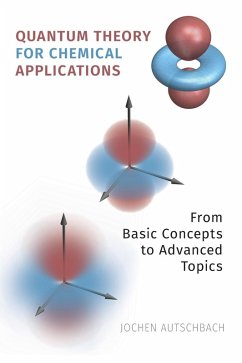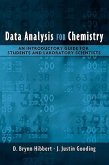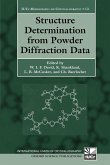- Gebundenes Buch
- Merkliste
- Auf die Merkliste
- Bewerten Bewerten
- Teilen
- Produkt teilen
- Produkterinnerung
- Produkterinnerung
This is a book about modern quantum chemistry, and it emphasizes the orbital models that are central to chemical applications of quantum theory.
Andere Kunden interessierten sich auch für
![Algebraic Theory of Molecules Algebraic Theory of Molecules]() Levine IachelloAlgebraic Theory of Molecules274,99 €
Levine IachelloAlgebraic Theory of Molecules274,99 €![Non-Linear Optical Properties of Matter Non-Linear Optical Properties of Matter]() Manthos G. Papadopoulos / Andrzej J. Sadlej / Jerzy Leszczynski (eds.)Non-Linear Optical Properties of Matter242,99 €
Manthos G. Papadopoulos / Andrzej J. Sadlej / Jerzy Leszczynski (eds.)Non-Linear Optical Properties of Matter242,99 €![Chemical Analysis Chemical Analysis]() Chemical Analysis200,99 €
Chemical Analysis200,99 €![Data Analysis for Chemistry Data Analysis for Chemistry]() D Brynn HibbertData Analysis for Chemistry126,99 €
D Brynn HibbertData Analysis for Chemistry126,99 €![Structure Determination from Powder Diffraction Data Structure Determination from Powder Diffraction Data]() W.I.F. David / K. Shankland / L.B. McCusker / C. Bärlocher (eds.)Structure Determination from Powder Diffraction Data111,99 €
W.I.F. David / K. Shankland / L.B. McCusker / C. Bärlocher (eds.)Structure Determination from Powder Diffraction Data111,99 €![Compendium of Chemical Warfare Agents Compendium of Chemical Warfare Agents]() Steven L. HoenigCompendium of Chemical Warfare Agents119,99 €
Steven L. HoenigCompendium of Chemical Warfare Agents119,99 €![Compendium of Chemical Warfare Agents Compendium of Chemical Warfare Agents]() Steven L. HoenigCompendium of Chemical Warfare Agents198,99 €
Steven L. HoenigCompendium of Chemical Warfare Agents198,99 €-
-
-
This is a book about modern quantum chemistry, and it emphasizes the orbital models that are central to chemical applications of quantum theory.
Hinweis: Dieser Artikel kann nur an eine deutsche Lieferadresse ausgeliefert werden.
Hinweis: Dieser Artikel kann nur an eine deutsche Lieferadresse ausgeliefert werden.
Produktdetails
- Produktdetails
- Verlag: Oxford University Press
- Seitenzahl: 760
- Erscheinungstermin: 21. Dezember 2020
- Englisch
- Abmessung: 257mm x 175mm x 41mm
- Gewicht: 1474g
- ISBN-13: 9780190920807
- ISBN-10: 0190920807
- Artikelnr.: 59764140
- Herstellerkennzeichnung
- Libri GmbH
- Europaallee 1
- 36244 Bad Hersfeld
- gpsr@libri.de
- Verlag: Oxford University Press
- Seitenzahl: 760
- Erscheinungstermin: 21. Dezember 2020
- Englisch
- Abmessung: 257mm x 175mm x 41mm
- Gewicht: 1474g
- ISBN-13: 9780190920807
- ISBN-10: 0190920807
- Artikelnr.: 59764140
- Herstellerkennzeichnung
- Libri GmbH
- Europaallee 1
- 36244 Bad Hersfeld
- gpsr@libri.de
Jochen Autschbach is a UB Distinguished Professor and Larkin Professor at University at Buffalo, The State University of New York. Autschbach has authored or co-authored over 300 scientific journal articles and academic book chapters.
* Preface
* Notation Used in This Book
* Motivation: Why it is Important to Know What Quantum Theory is About
* Part I: Basic Theoretical Concepts
* Chapter 1: Vectors and Functions and Operators
* Chapter 2: Classical Mechanics According to Newton, Langrange, and
Hamilton
* Chapter 3: The Quantum Recipe
* Chapter 4: Atomic Units
* Chapter 5: A First Example: The "Particle in a Box" and Quantized
Translational Motion
* Part II: Atomic, Molecular, and Crystal Orbitals
* Chapter 6: Hydrogen-Like Wave Functions: A First Sketch
* Chapter 7: Many Electron Systems and the Pauli Principle
* Chapter 8: Self-Consistent Field (SCF) Orbital Methods
* Chapter 9: From Atomic Orbitals to Molecular Orbitals and Chemical
Bonds
* Chapter 10: Orbital-Based Descriptions of Electron Configurations,
Ionization, Excitation, and Bonding
* Chapter 11: Recap: Molecular Orbitals and Common Misconceptions
* Chapter 12: Approximate Molecular Orbital Theory: The
Hückel/Tight-Binding Model
* Chapter 13: Band Structure Theory for Extended Systems
* Part III: Basic Concepts of Quantum Theory Continued
* Chapter 14: Quantized Vibrational Motion
* Chapter 15: Quantized Rotational Motion in a Plane
* Chapter 16: Angular Momentum and Rational Motion in Three Dimensions
* Chapter 17: Hydrogen-Like Atoms
* Chapter 18: Particle in a Cylinder, in a Sphere, and on a Helix
* Chapter 19: Electron Spin and General Angular Momenta
* Part IV: Advanced Topics
* Chapter 20: Post-Hartree-Fock Methods and Electron Correlation: A
Very Brief Overview
* Chapter 21: The One-Electron Quantum Hamiltonian in the Presence of
Electromagnetic Fields
* Chapter 22: Static Perturbation Theory and Derivative Properties
* Chapter 23: Dynamic Fields and Response Properties
* Chapter 24: From Schrödinger to Einstein: Relativistic Effects
* Part V: Appendix
* A. Complex Numbers
* B. Linear Algebra Essentials
* C. Some Useful Relationships Involving Functions, Vector Fields, and
the Operator V
* D. One- and Two-Center Integrals Over 1s Slater-Type Functions
* E: Point Group Symmetry
* F. Ensembles of Electrons and Quantum Statistics
* G. Gaussian and CGS Units
* H. Solutions for Selected Exercises
* Further Reading
* Index
* Notation Used in This Book
* Motivation: Why it is Important to Know What Quantum Theory is About
* Part I: Basic Theoretical Concepts
* Chapter 1: Vectors and Functions and Operators
* Chapter 2: Classical Mechanics According to Newton, Langrange, and
Hamilton
* Chapter 3: The Quantum Recipe
* Chapter 4: Atomic Units
* Chapter 5: A First Example: The "Particle in a Box" and Quantized
Translational Motion
* Part II: Atomic, Molecular, and Crystal Orbitals
* Chapter 6: Hydrogen-Like Wave Functions: A First Sketch
* Chapter 7: Many Electron Systems and the Pauli Principle
* Chapter 8: Self-Consistent Field (SCF) Orbital Methods
* Chapter 9: From Atomic Orbitals to Molecular Orbitals and Chemical
Bonds
* Chapter 10: Orbital-Based Descriptions of Electron Configurations,
Ionization, Excitation, and Bonding
* Chapter 11: Recap: Molecular Orbitals and Common Misconceptions
* Chapter 12: Approximate Molecular Orbital Theory: The
Hückel/Tight-Binding Model
* Chapter 13: Band Structure Theory for Extended Systems
* Part III: Basic Concepts of Quantum Theory Continued
* Chapter 14: Quantized Vibrational Motion
* Chapter 15: Quantized Rotational Motion in a Plane
* Chapter 16: Angular Momentum and Rational Motion in Three Dimensions
* Chapter 17: Hydrogen-Like Atoms
* Chapter 18: Particle in a Cylinder, in a Sphere, and on a Helix
* Chapter 19: Electron Spin and General Angular Momenta
* Part IV: Advanced Topics
* Chapter 20: Post-Hartree-Fock Methods and Electron Correlation: A
Very Brief Overview
* Chapter 21: The One-Electron Quantum Hamiltonian in the Presence of
Electromagnetic Fields
* Chapter 22: Static Perturbation Theory and Derivative Properties
* Chapter 23: Dynamic Fields and Response Properties
* Chapter 24: From Schrödinger to Einstein: Relativistic Effects
* Part V: Appendix
* A. Complex Numbers
* B. Linear Algebra Essentials
* C. Some Useful Relationships Involving Functions, Vector Fields, and
the Operator V
* D. One- and Two-Center Integrals Over 1s Slater-Type Functions
* E: Point Group Symmetry
* F. Ensembles of Electrons and Quantum Statistics
* G. Gaussian and CGS Units
* H. Solutions for Selected Exercises
* Further Reading
* Index
* Preface
* Notation Used in This Book
* Motivation: Why it is Important to Know What Quantum Theory is About
* Part I: Basic Theoretical Concepts
* Chapter 1: Vectors and Functions and Operators
* Chapter 2: Classical Mechanics According to Newton, Langrange, and
Hamilton
* Chapter 3: The Quantum Recipe
* Chapter 4: Atomic Units
* Chapter 5: A First Example: The "Particle in a Box" and Quantized
Translational Motion
* Part II: Atomic, Molecular, and Crystal Orbitals
* Chapter 6: Hydrogen-Like Wave Functions: A First Sketch
* Chapter 7: Many Electron Systems and the Pauli Principle
* Chapter 8: Self-Consistent Field (SCF) Orbital Methods
* Chapter 9: From Atomic Orbitals to Molecular Orbitals and Chemical
Bonds
* Chapter 10: Orbital-Based Descriptions of Electron Configurations,
Ionization, Excitation, and Bonding
* Chapter 11: Recap: Molecular Orbitals and Common Misconceptions
* Chapter 12: Approximate Molecular Orbital Theory: The
Hückel/Tight-Binding Model
* Chapter 13: Band Structure Theory for Extended Systems
* Part III: Basic Concepts of Quantum Theory Continued
* Chapter 14: Quantized Vibrational Motion
* Chapter 15: Quantized Rotational Motion in a Plane
* Chapter 16: Angular Momentum and Rational Motion in Three Dimensions
* Chapter 17: Hydrogen-Like Atoms
* Chapter 18: Particle in a Cylinder, in a Sphere, and on a Helix
* Chapter 19: Electron Spin and General Angular Momenta
* Part IV: Advanced Topics
* Chapter 20: Post-Hartree-Fock Methods and Electron Correlation: A
Very Brief Overview
* Chapter 21: The One-Electron Quantum Hamiltonian in the Presence of
Electromagnetic Fields
* Chapter 22: Static Perturbation Theory and Derivative Properties
* Chapter 23: Dynamic Fields and Response Properties
* Chapter 24: From Schrödinger to Einstein: Relativistic Effects
* Part V: Appendix
* A. Complex Numbers
* B. Linear Algebra Essentials
* C. Some Useful Relationships Involving Functions, Vector Fields, and
the Operator V
* D. One- and Two-Center Integrals Over 1s Slater-Type Functions
* E: Point Group Symmetry
* F. Ensembles of Electrons and Quantum Statistics
* G. Gaussian and CGS Units
* H. Solutions for Selected Exercises
* Further Reading
* Index
* Notation Used in This Book
* Motivation: Why it is Important to Know What Quantum Theory is About
* Part I: Basic Theoretical Concepts
* Chapter 1: Vectors and Functions and Operators
* Chapter 2: Classical Mechanics According to Newton, Langrange, and
Hamilton
* Chapter 3: The Quantum Recipe
* Chapter 4: Atomic Units
* Chapter 5: A First Example: The "Particle in a Box" and Quantized
Translational Motion
* Part II: Atomic, Molecular, and Crystal Orbitals
* Chapter 6: Hydrogen-Like Wave Functions: A First Sketch
* Chapter 7: Many Electron Systems and the Pauli Principle
* Chapter 8: Self-Consistent Field (SCF) Orbital Methods
* Chapter 9: From Atomic Orbitals to Molecular Orbitals and Chemical
Bonds
* Chapter 10: Orbital-Based Descriptions of Electron Configurations,
Ionization, Excitation, and Bonding
* Chapter 11: Recap: Molecular Orbitals and Common Misconceptions
* Chapter 12: Approximate Molecular Orbital Theory: The
Hückel/Tight-Binding Model
* Chapter 13: Band Structure Theory for Extended Systems
* Part III: Basic Concepts of Quantum Theory Continued
* Chapter 14: Quantized Vibrational Motion
* Chapter 15: Quantized Rotational Motion in a Plane
* Chapter 16: Angular Momentum and Rational Motion in Three Dimensions
* Chapter 17: Hydrogen-Like Atoms
* Chapter 18: Particle in a Cylinder, in a Sphere, and on a Helix
* Chapter 19: Electron Spin and General Angular Momenta
* Part IV: Advanced Topics
* Chapter 20: Post-Hartree-Fock Methods and Electron Correlation: A
Very Brief Overview
* Chapter 21: The One-Electron Quantum Hamiltonian in the Presence of
Electromagnetic Fields
* Chapter 22: Static Perturbation Theory and Derivative Properties
* Chapter 23: Dynamic Fields and Response Properties
* Chapter 24: From Schrödinger to Einstein: Relativistic Effects
* Part V: Appendix
* A. Complex Numbers
* B. Linear Algebra Essentials
* C. Some Useful Relationships Involving Functions, Vector Fields, and
the Operator V
* D. One- and Two-Center Integrals Over 1s Slater-Type Functions
* E: Point Group Symmetry
* F. Ensembles of Electrons and Quantum Statistics
* G. Gaussian and CGS Units
* H. Solutions for Selected Exercises
* Further Reading
* Index








